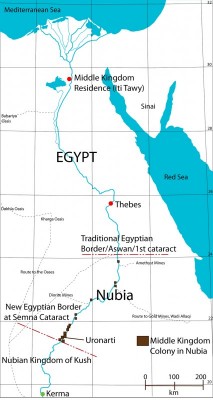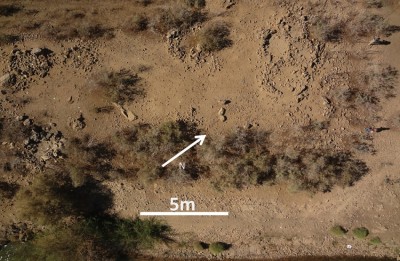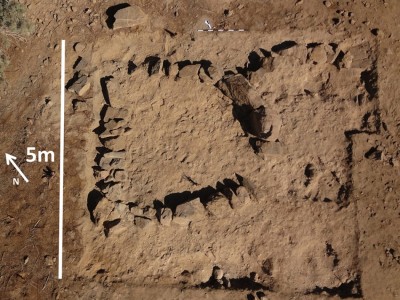Living beyond the walls: new evidence for Egyptian colonialism at Uronarti, Nubia
Introduction
The Uronarti Regional Archaeology Project (URAP) was formed in 2012 to investigate a Middle Kingdom (c. 2010–1685 BC) Egyptian colonial outpost on the Nile island of Uronarti (modern north Sudan) (Knoblauch & Bestock in press). The site is characterised by a monumental fortress, one of a string of such sites built by the Egyptians to control a stretch of the Nile beyond Egypt’s traditional southern border (Figure 1). The area controlled by these fortresses is almost exactly congruent with the lake that rose behind the Aswan High Dam in Egypt in the 1960s, and it was long presumed that all archaeological sites in this area were lost (Vercoutter 1995). Recently, however, it was reported that two of the fortresses—Uronarti and Shalfak—have survived the flooding (Welsby 2004). The rediscovery of Uronarti and the foundation of the URAP offer an opportunity to ask new questions. Earlier research on this system of Middle Kingdom fortresses has, with few exceptions (e.g. Smith 1995), concentrated on specific colonisation events rather than broader colonial relations (see van Dommelen 1997). URAP is concerned with investigating the lived experience of colonialism in this region from the perspective of both Egyptians and Nubians. A significant step in this process has been the discovery of a substantial extra-mural site, Site FC, which is contemporary with the fortress and the focus of this report.
Background
In the early second millennium BC, the Egyptian state expanded its border southwards into Nubia, taking control of the gold-bearing regions between the First Nile Cataract, near Aswan (the traditional southern border of Egypt), and the Semna Cataract, some 800km farther south. The motivations for this first programme of external colonisation in Egyptian history were the extraction of local resources and the facilitation of river-based trade in luxury items and resources with Kush, the powerful polity that was emerging beyond the sphere of direct Egyptian control near the Third Nile Cataract.
The Egyptian fortress settlement on Uronarti is paradigmatic for the final phase of the building of the system of fortresses (Figure 2). Situated at the highest point of a rocky outcrop, with heavy external fortification walls originally over 10m in height, it represented a highly visible ‘public’ statement of colonial domination. Internally, the settlement was laid out on a grid based on the Egyptian cubit; it accommodated centrally organised colonial institutions, including granaries and barracks. This architecture indicates restrictions on access to and movement around the site and the highly structured nature of colonial life.
Site FC
The situation at Site FC presents a marked contrast to the Egyptian fortress. Here, the spatial organisation and construction techniques originate in a different tradition of architecture. The site was discovered during a survey of the eastern side of Uronarti; it lies approximately 250m from the fortress (Figure 3). An initial survey has recorded 25 piles of tumbled stones ranging in diameter from 2.5–4m, collectively extending over an area of more than 2000m2. Within this area, some of these piles of stone are clustered and others isolated. Aerial photographs from the 1950s suggest that the site may have originally extended along the entire eastern shore of the island.
The regularity of the stone piles is apparent from kite aerial images (Figure 4), and excavation confirms that they are the remains of dwellings constructed using unworked local stone. The excavated example is a roughly D-shaped structure, 3m long on its straight side (Figure 5). There is a doorway on the south, leeward, side and a short spur wall defining an annex on the east. Insufficient stones remained in the pile to have constructed walls sufficiently tall for an enclosed structure; rather, the upper walls and any roof were probably comprised of lighter materials. Remnants of burning indicate the presence of a small hearth in the west corner of the structure. Two small pits full of ash, broken ceramic sherds and some faunal bone lay immediately outside the door. The wider site itself does not seem to have been surrounded by a wall.
The ceramics from the survey and excavation at Site FC are Egyptian in form, and date to the period in which the fortress was first occupied (Figure 6). Remarkably, nearly all of the ceramics have indications of secondary reuse after breakage. Reworked pottery sherds, in particular, seem to have been highly prized as scrapers and blades. So far, these are the only types of tools recovered from the site. Clay moulds for baking bread are absent, despite their ubiquity at the fortress.
Significance
The architecture and ceramics indicate that Site FC was a substantial settlement whose inhabitants led a somewhat different lifestyle to those within the rectilinear mud-brick walls of the fortress barracks. While they may have been dependent on the fortress for staples, they may have been left to fend for themselves in other ways, living literally and figuratively beyond the protective walls of the fortress enclosure. Who were these people and where did they come from? What was their relationship to the social groups that made up the fortress community? Were they the families of the men stationed inside the fortress? Or were they overflow—perhaps lower status—troops? Or personnel providing services for the fortress population? And how did state controls affect their lives?
Although questions are more forthcoming than answers at this stage, the discovery and initial work at Uronarti, Site FC, demonstrate that the relationship between colonial Egyptians and the local landscape, both geographical and cultural, was more complex than previously believed.
Acknowledgements
We thank the Sudan National Corporation of Antiquities and Museums, and particularly Shadia Abderabo, our inspector. David Edwards graciously provided digital copies of mid twentieth-century aerial photographs. Support was provided by the Brennan Foundation and Brown University.
References
- KNOBLAUCH, C. & L. BESTOCK. In press. The Uronarti Regional Archaeological Project: report of the first season. Mitteilungen des Deustschen Archäologischen Instituts, Abteilung Kairo.
- SMITH, S.T. 1995. Askut in Nubia: the economics and ideology of Egyptian imperialism in the second millennium B.C. London & New York: Kegan Paul.
- VAN DOMMELEN, P. 1997. Colonial constructs: colonialism and archaeology in the Mediterranean. World Archaeology 28: 305–23. http://dx.doi.org/10.1080/00438243.1997.9980350 * VERCOUTTER, J. 1995. Les fortress égyptiennes du Bath el-Haggar ou les failles d’une campagne. Cahier de recherches de l’Institut de Papyrologie et d’Égyptologie de Lille 17: 25–35 * WELSBY, D. 2004. Hidden treasures of Lake Nubia. Sudan and Nubia 8: 103–104.
Authors
* Author for correspondence.
- Laurel Bestock*
Joukowsky Institute for Archaeology and the Ancient World, Brown University, 60 George Street, Providence (RI), USA (Email: laurel_bestock [at] brown.edu) - Christian Knoblauch
Institut für Orientalische und Europäische Archäologie, Österreichische Akademie der Wissenschaften, Postgasse 7/1/10 A-1010 Wien, Austria (Email: christian.knoblauch [at] oeaw.ac.at)





